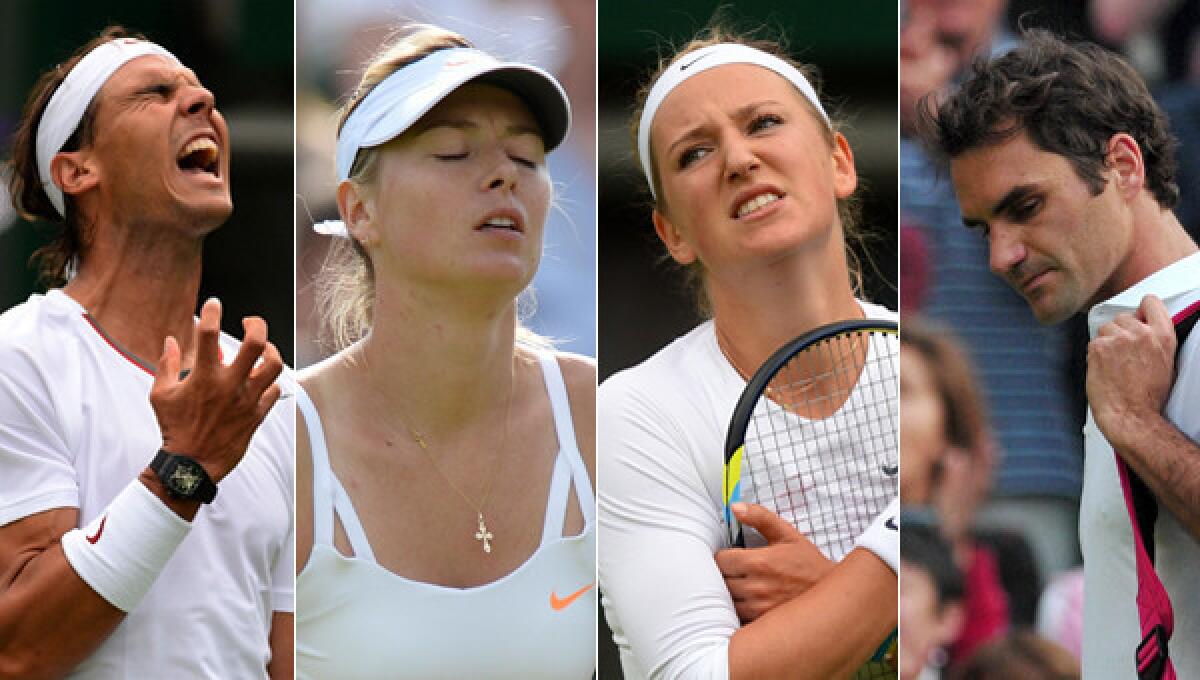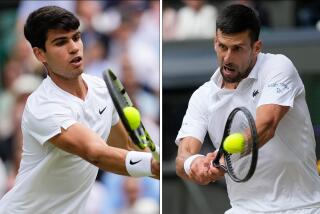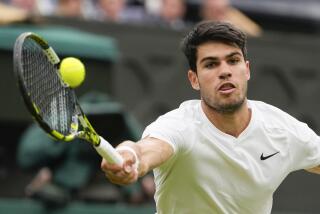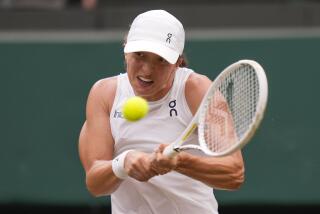First-week shock waves reverberate as Wimbledon begins Week 2

- Share via
WIMBLEDON, England — Surely, someone made a mistake.
The intended order of play for the round of 16 at Wimbledon on Monday omitted seven-time champion Roger Federer and two-time champion Rafael Nadal. World No. 3 Maria Sharapova and two-time Australian Open winner Victoria Azarenka were missing too.
Surprisingly, there was no error. A run of first-week injuries and upsets turned Wimbledon on its genteel ear and ushered out Federer, Nadal, Sharapova, Azarenka and other headliners. Only five of the top 12 women’s seeds remain. The same is true for the men.
“We had Wimblegeddon,” said American Sloane Stephens, still standing at No. 17 to face Monica Puig of Puerto Rico.
“People were dropping like flies.”
The No. 1 seeds have stayed above the fray without losing a set. Serena Williams will face No. 23 Sabine Lisicki of Germany on Center Court, and Novak Djokovic of Serbia will face No. 13 Tommy Haas of Germany after No. 2 Andy Murray plays Mikhail Youzhny of Russia. The draw looks strange to Williams and Djokovic from their lofty perches.
“I feel like this might be the beginning of maybe the future,” Williams said. “Eventually there’s going to have to be a shift of players.”
True. It’s just that no one expected it so soon.
“It’s a bit strange feeling not to have Federer or Nadal at the second week of a major. In the last 10 years it was always one of them,” Djokovic said. “But it’s the way it is. There’s some players who have been playing great tennis. I think it’s interesting also to see new faces for the crowd, for the tennis world in general.”
Was it good that tennis experienced what ESPN commentator Patrick McEnroe called “a perfect storm of craziness,” when Sharapova, Azarenka and Federer tumbled on Wednesday? Or will the absence of familiar faces drive fans away?
Chris Evert, who has three Wimbledon wins among her 18 Grand Slam titles, said Grand Slams “are the tournaments that create new stars, more than any other tournament.” That applies to players who can capitalize on the craziness here.
“Looking ahead to the future, it’s good. For these two weeks, everybody wants to see their stars — the Rogers and the Marias — play,” said Evert, now an ESPN commentator. “But with any change there’s always a negative and a positive. If stars can emerge from this, then it has to be good. I think it’s good for American tennis because in Sloane and Madison [Keys], we have two potential players that could win a Slam in the future. We’re testing them to see where they are right now.
“Big-picture-wise, it’s good. Short-term-wise, no.”
It’s especially unfortunate that Sergiy Stakhovsky, the Ukrainian who upset Federer in the second round, and Steve Darcis, the Belgian who took out Nadal in the first round, couldn’t build on their sudden fame. Stakhovsky lost in the next round and Darcis withdrew because of a shoulder injury.
“I would say overall it’s better for the sport if the top players are in there at the end,” McEnroe said. “For the tennis fans, this makes it maybe a little more exciting. For the average fan, they’re going to be more interested in Federer, Nadal and Sharapova.”
Evert said that the grass-court season is too short and that the two-week gap between the French Open and Wimbledon wasn’t enough to adjust from clay to grass. Nadal, she said, played his opening match “like a clay-court player,” staying far behind the baseline.
Evert also said the rain-dampened surfaces contributed to the upsets. “Tennis is more athletic now. It’s more about power,” she said. “The fact that the players feel they can’t go all out when they move, like the first few rounds, because the courts are damp, is such an equalizer.
“And the thing is, in my day they weren’t hitting the ball as hard, so I could measure my steps better. And I had more time to get to the ball. Nowadays, they’re sprinting to the ball, they’re turning, changing directions more quickly. Players are using the whole court more. So you’re getting this slickness of the court coming into effect.”
McEnroe said the brief gap between the French Open and Wimbledon “has been that way forever,” and probably wasn’t a widespread problem here. He said he’d like to see more grass-court events because they test skills more than those on other surfaces, and said Wimbledon officials should give players more practice time on the courts. “So they look more like this at the start of play,” he said, pointing to scuffed, worn patches on Court 18, “rather than the beautiful green, which we all love.”
McEnroe said he expects Murray to reach the final, with No. 24 Jerzy Janowicz of Poland as his biggest potential obstacle now that Federer and Nadal are gone. Djokovic has challenges in his section but should be there too. “On the women’s side, it would be pretty much of a shocker to not see Serena win it at this point,” McEnroe said. “But then again, no one would have said Federer was going to be out in the second round and Nadal in the first round.”
No mistake there.
“I guess,” Evert said, “the whole beauty of Wimbledon this year is just the mystery of it.”
twitter.com/helenenothelen
More to Read
Go beyond the scoreboard
Get the latest on L.A.'s teams in the daily Sports Report newsletter.
You may occasionally receive promotional content from the Los Angeles Times.











